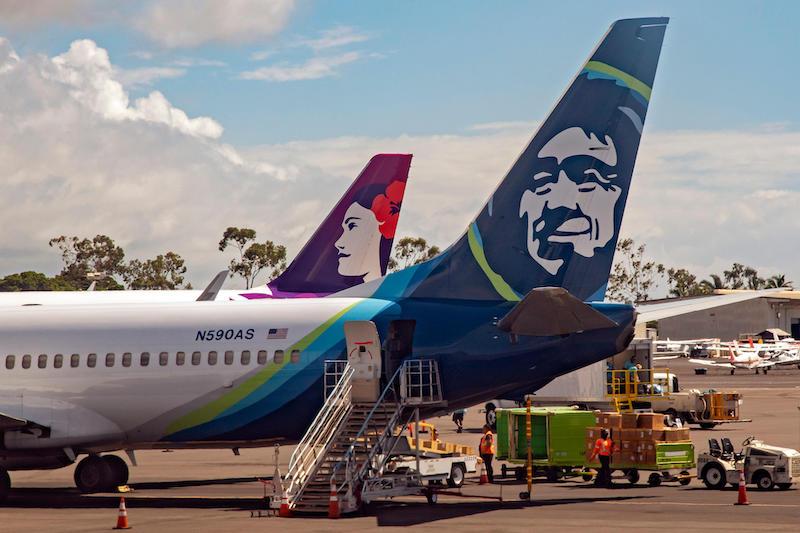
Alaska Airlines’ proposed $1.9 billion acquisition of Hawaiian Airlines is set to establish a network spanning more than 330 routes, potentially creating a group with a leading position in the Hawaii-U.S. mainland market.
On Dec. 3, Alaska Air Group said it would pay $18 per share in cash for each share of Hawaiian, whose stock closed Dec. 1 at $4.86. The planned deal has been approved by both airline boards but will face scrutiny from U.S. regulators at a time when the Biden administration is seeking to resist more airline consolidation.
Should the transaction be given the green light, Alaska has stressed a commitment to maintain the separate brands. Approval will also see the deal become the Oneworld alliance member’s second in less than a decade following the purchase of Virgin America in 2016.
Analysis of data from OAG Schedules Analyser reveals that Alaska is the fifth-largest airline in the U.S. domestic market during December 2023, accounting for 4.9% of all departure seats within the country. Hawaiian is the 10th largest with a 1.25% capacity share.
A combination between the two will therefore create a group with about 6.15% of the market, maintaining Alaska’s position as the fifth-largest provider. However, it would likely drop to sixth should JetBlue’s proposed merger with Spirit Airlines secure regulatory clearance.
Alaska and Hawaiian offer a combined 336 domestic and international routes during December 2023, with direct competition existing in 12 markets. Alaska flies a total of 301 nonstop routes this month, while Hawaiian provides connections between 47 airport pairs.
Twenty-eight routes in Hawaiian’s network link the state of Hawaii with the U.S. mainland. Alaska serves 12 of these routes, equating to an overlap of 43% of Hawaiian’s Hawaii-mainland U.S. network and a 25.5% overlap of Hawaiian’s overall network. Meanwhile, Alaska’s Hawaii-mainland U.S. network spans 24 routes, meaning Hawaiian currently serves half of them.
Of the 12 overlapping routes, six originate from Honolulu’s Daniel K. Inouye International Airport (HNL), and an additional six originate from Maui’s Kahului Airport (OGG). From the two airports, both Alaska and Hawaiian serve Los Angeles, Portland, San Diego, San Francisco, San Jose Mineta and Seattle-Tacoma.
The latest OAG data shows that Hawaiian and Alaska are the second- and third-largest providers of Hawaii-U.S. mainland capacity at present, behind United Airlines in first position. United has a 23.5% capacity share in December 2023, with Hawaiian on 23.2% and Alaska on 16.9%.
Based on current schedules—and ignoring any potential merger remedies—a combined Alaska/Hawaiian group would therefore account for more than 40% of all airline seat capacity on Hawaii-U.S. mainland routes.
Looking at Hawaiian’s total U.S. mainland network, the airline serves a total of 15 destinations from HNL, including East Coast flights to Boston Logan International Airport and New York John F. Kennedy International Airport, and 10 cities from OGG. It also serves Los Angeles from Lihue (LIH) and Kona (KOA), as well as flying Lihue-Oakland nonstop.
Alaska offers 24 routes between the U.S. mainland and Hawaii, eight of which are to HNL, seven to OGG, five to KOA and four to LIH. All four Hawaiian airports are each served from Alaska’s hubs in Seattle, Portland, San Diego and San Jose.
As well as increasing Alaska’s presence in the U.S. mainland-Hawaii and the intra-island Hawaii markets, the planned acquisition of Hawaiian will expand the group’s international footprint beyond the six countries served by the airline, including an entrance into the Asia-Pacific region.
Hawaiian currently offers flights to 10 international destinations across seven countries—none of which are served by Alaska. They comprise Auckland, New Zealand; Fukuoka, Osaka, Tokyo Haneda and Tokyo Narita, Japan; Pago Pago, American Samoa; Rarotonga Island, Cook Islands; Seoul Incheon, South Korea; Sydney, Australia; and Tahiti, French Polynesia.
As reported by Aviation Week, Alaska has yet to speak with the government about the Hawaiian deal, Alaska CEO Ben Minicucci told investors, but he expressed confidence in its uniqueness, noting that of about 1,400 flights a day, the combined network would have just 12 overlap markets.
“With this acquisition, Alaska adds another top-25 U.S. market to our network, making Honolulu our second-largest hub,” he said. “We've become the clear leader in the $8 billion Hawaii market, unlocking hub economics and one of the most globally attractive leisure markets with a proven long-term track record of profitability.”
Analysis of the latest OAG schedules shows Seattle-Tacoma International Airport will continue to be the group’s largest hub should the deal complete, and HNL will become Alaska’s second largest. Kahului and Kona would also enter the top 10 largest by capacity.
